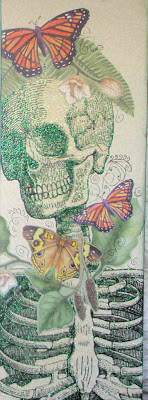 It might be Springtime but I'm still spooky. So what do spooky girls play with during the year's greening? Dead fairies, spider webs, and moonlit tea parties - oh my! Now, are these fairies the ghostly spirits of long deceased sprites or are they the collected corpses of unlucky tinker wannabes? Let's look at how various artists portray the matter... and yes I did find many tackling the oddball topic.
It might be Springtime but I'm still spooky. So what do spooky girls play with during the year's greening? Dead fairies, spider webs, and moonlit tea parties - oh my! Now, are these fairies the ghostly spirits of long deceased sprites or are they the collected corpses of unlucky tinker wannabes? Let's look at how various artists portray the matter... and yes I did find many tackling the oddball topic.Brassnbedlam's Curious Taxidermy
Some of the most realistic and truly creepy Dead Fairies I've come across are by the Steampunk artist Brassnbedlam. These are meant to look like actual scientific specimens complete with notes. They look a bit gooey and still have some fleshy parts like their ears... ick. I'm fascinated by the psuedo scientific approach to fairies as a candidate for cryptozoology.
To see more of her work on flickr: http://www.flickr.com/photos/brassnbedlam/3295328455/
 Above is her Welsh Blue Fairy, mummified and mounted in a shadowbox frame with real butterfly wings.
Above is her Welsh Blue Fairy, mummified and mounted in a shadowbox frame with real butterfly wings.
 "Speckled English Fairy, mummified and mounted in a shadowbox/ frame with real butterfly wings, made by my fair chap, a lovely handmade creepy and macabre steampunk specimen, a dead fairy and comes with historical notes"
"Speckled English Fairy, mummified and mounted in a shadowbox/ frame with real butterfly wings, made by my fair chap, a lovely handmade creepy and macabre steampunk specimen, a dead fairy and comes with historical notes" VooDoo Willy's Fairy Art Sculptures
VooDoo Willy's Fairy Art SculpturesThis dark fantasy artist on Etsy produces some of the most interesting pieces I've seen. Each is a one of kind creation from the 'dark corners' of his mind... A keen sense of humor with a heavy dose of gloom has lead to the sculptures below. To see his shop: http://www.etsy.com/shop/VooDooWilly
Below: "The Battle"
 Below: "Morbid Martini"
Below: "Morbid Martini" Below: "Stopping to smell the roses"
Below: "Stopping to smell the roses"
 A Well Crafted Hoax?
A Well Crafted Hoax?"A CRAFTSMAN IN England has posted on his website photos of what he claims to be a mummified fairy located in Derbyshire, England. What is unusual about the photos compared to the usual paranormal images, either of live or of dead cryptids (unknown animals) is that there are many of them, in full color, from multiple angles" giving the appearance of realism. Apparently this guy tried to pull off that he had found actual fairy corpses. Ok.
A few days before April 1, 2007, Dan Baines, a 31-year-old illusion designer for magicians from London, posted on his website images of the "corpse" of an unknown eight-inch creation. The unusual corpse was claimed to be the mummified remains of a fairy which was discovered by a dog walker at Firestone Hill in Duffield, Derbyshire. Read more below:
http://paranormal.about.com/od/othercreatures/a/aa033107.htm
 Below is another attempt at fanciful fairy taxidermy, artist unknown.
Below is another attempt at fanciful fairy taxidermy, artist unknown. Below is a project page for how to make your own Dead Fairy prop, by Shadow Manor
Below is a project page for how to make your own Dead Fairy prop, by Shadow Manorhttp://www.shadowmanor.com/blog/?page_id=4666
 The Fancifully Morbid works of Etsy artist Fairy Garden:
The Fancifully Morbid works of Etsy artist Fairy Garden:Fairy Garden's dead fey are a bit more fanciful, with bouquets and tutus. I love her 'Fairy Trap' which uses a large crystal as bait- what fairy could resist! Below are a few of my favorites examples.
Visit her store: http://www.etsy.com/shop/fairygarden




































